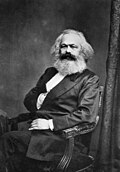Market forms
In economics, market structure (also known as market form) describes the state of a market with respect to competition.
Most market forms given below talk about a homogeneous product. This simply means that they all make the same thing. They simply want to get the cheapest one, since all kinds of sugars (or soaps) look the same anyway.
The major market forms are:
- Perfect competition: there are many numbers of buyers as well as many numbers of sellers, all the producers sell the homogeneous product and price remains unchanged
- Monopolistic competition, also called competitive market: there are a large number of independent firms. Each firm has a very small proportion of the market share.
- Oligopoly: A market is dominated by a small number of firms which own more than 40% of the market share.
- Oligopsony: A market dominated by many sellers and a few buyers.
- Monopoly: There is only one seller and many number of buyers.
- Natural monopoly: A monopoly in which economies of scale cause efficiency to increase continuously with the size of the firm.
- Monopsony: There is only one buyer in the market.
The imperfectly competitive structure is quite identical to the realistic market conditions where some monopolistic competitors, monopolists, oligopolists, and duopolists exist and dominate the market conditions.
These somewhat abstract concerns usually determine some but not all details of a specific concrete market system where buyers and sellers actually meet and commit to trade.
| Market Structure | Seller Entry Barriers | Seller Number | Buyer Entry Barriers | Buyer Number |
|---|---|---|---|---|
| Perfect competition | No | Many | No | Many |
| Monopolistic competition | No | Many | No | Many |
| Oligopoly | Yes | Few | No | Many |
| Oligopsony | No | Many | Yes | Few |
| Monopoly | Yes | One | No | Many |
| Monopsony | No | Many | Yes | One |
The correct sequence of the market structure from most to least competitive is perfect competition, imperfect competition, oligopoly, and pure monopoly.
The main criteria by which one can distinguish between different market structures are: the number and size of producers and consumers in the market, the type of goods and services being traded, and the degree to which information can flow freely.
Market Forms Media
Related pages
Other websites
- Microeconomics Archived 2006-04-18 at the Wayback Machine by Elmer G. Wiens: Online Interactive Models of Oligopoly, Differentiated Oligopoly, and Monopolistic Competition

